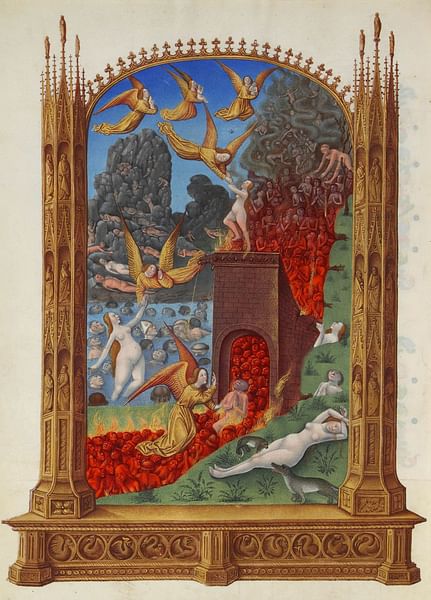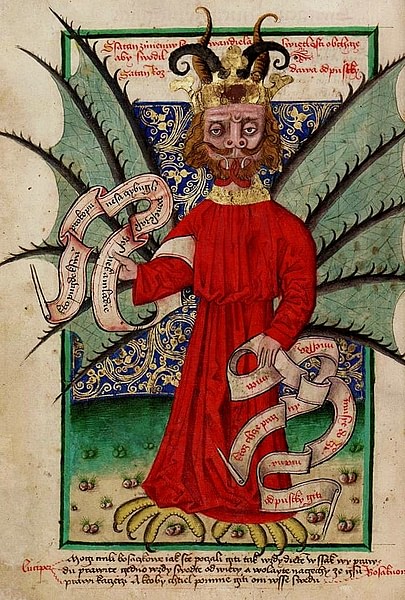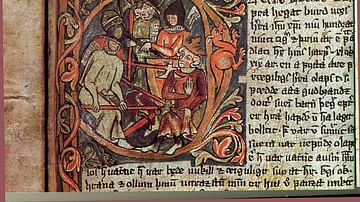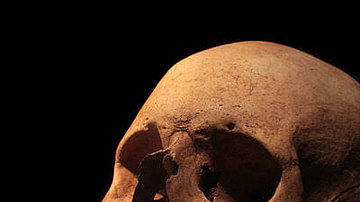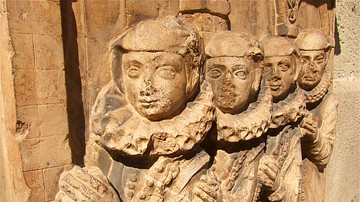The medieval Church informed the people's religious imagination during the Middle Ages (c. 476-1500) and the world was therefore interpreted - even by heterodox Christians - through the Church's lens. Ghosts – referred to as revenants – were no exception in that the Church defined such apparitions as souls in purgatory requiring human intervention to find eternal peace.
In the Early Middle Ages (c. 476-1000), there was no consensus on the meaning of ghostly appearances since, following the biblical injunction to "test all spirits", it was usually thought that such an apparition was a demon. As the Church began to emphasize the reality of purgatory, however, the concept of the ghost-as-soul-in-purgatory gained more ground.
The souls most likely to return to haunt the living were those whose burial rituals were not performed correctly or who had unfinished business which required closure; suicides, women who died in childbirth, or people who died suddenly and tragically without time for confession and absolution. Another reason, often entwined with these, was the need of the living to properly say goodbye and let the deceased person go. Elaborate rituals developed to enable the living to cope with the loss of death, release their memories of the dead in order to lay a ghost to rest, and move on with life.
Ghosts in the Ancient World
In the Early Middle Ages, the Church distanced itself from the concept of ghosts as understood by pagan Rome – as the disembodied spirits of the dead – and interpreted them as demonic entities. The biblical epistle of I John 4:1-3 warns believers that not every spirit is "from God" and they should be carefully evaluated for demonic origin. If an apparition appeared in the form of one's departed loved one, it was most likely a demon assuming that shape in order to damn one by tempting them to question God's plan.
The Church taught that God was in ultimate control of every aspect of one's life and that, when one died, there was a place for every soul in the afterlife – in heaven, hell and, eventually, the in-between of purgatory – just as there had been in the social hierarchy of life. A ghost threatened that understanding because it was not only out of place but had returned to where it no longer belonged. If God actually was in control, how did a ghost slip its assigned place in the afterlife to return to the living? The answer, reflecting the I John 4 passage, was that the apparition was not a 'ghost' but a demon in disguise.
Prior to the rise of Christianity, ghosts were understood as a natural – albeit uncomfortable and unwanted – aspect of human existence. The pagan belief systems held to the same understanding of ghosts that the Church would eventually adopt – that spirits of the dead could return to ask help from the living in completing unfinished business, to punish the living for incomplete or inadequate funerary rites, or because some aspect of their death left them unsettled – but this concept was at first resisted by the medieval Church.
In ancient Egypt, people could write letters to the dead addressing problems ranging from why the writer was being haunted or experiencing misfortune to asking where some treasured artifact or document had been placed. In Greece, the continued existence of the dead depended on the memory of the living as expressed in monuments and rituals. The more vibrant the memory, the more vital the spirit in the afterlife. This same paradigm was understood and observed by the Romans who developed societies a citizen paid into which, upon one's death, ensured proper funerary rites and continued remembrance. An apparition, in all three of these belief systems, was a sign that the soul of the deceased was not at rest and some action was required on the part of the living.
The Church had to distance itself from this understanding in the same way it did with all other aspects of pagan thought in order to make its message completely new. Ghosts were demonized in the same way women, cats, attention to personal hygiene, and anything else valued by the pagans were.
Purgatory
The Church's view changed in the 11th and 12th centuries with the development of the concept of purgatory. The vision of purgatory is first expressed by Plato (l. 428/427-348/347 BCE) in his dialogue of the Phaedo (107c-108d) where he depicts souls carrying the weight of their sins – not bad enough to be sentenced to the lowest level of the underworld, Tartarus, but not good enough for the paradise of the Elysium Fields – caught in currents which swirl them about until they have been purged of their transgressions. Plato, considered one of the 'noble pagans' by the Church, provided Christianity with much of its foundational dogma but the concept of purgatory was not fully developed until the High Middle Ages (1000-1300) at which time it became accepted as a spiritual reality.
Purgatory took root in the popular imagination through medieval folklore, especially the motif known as the Wild Hunt, a vision of the departed which was thought to bring death or grave misfortune to anyone who witnessed it but also established the existence of a realm from which the dead could appear distinct from heaven or hell. The Wild Hunt originated in Scandinavia and was associated with Odin and his warriors of Valhalla. The typical story involves an innocent spectator out about some business who sees a ghostly hunting party or group of armed men, led by or associated with Odin, who appear suddenly with all the noise and sounds of the living to vanish away silently just as quickly.
The pagan Norse motif was developed in Christian Europe to reflect Christian ideals and, notably, the concept of purgatory. The most famous of these kinds of stories is Herlequin's Hunt (also known as Helething's Hunt) recorded by the Anglo-Norman historian Orderic Vitalis (l. 1075-1142) in his Ecclesiastical History. It is important to note that Vitalis, a respected historian still cited reliably in the present day, does not record the vision as a folktale or hearsay but as an actual historical event which he even dates firmly as occurring on 1 January 1091.
Vitalis writes how a Norman parish priest named Walchelin went out that night to visit a sick parishioner on the outskirts of town. On his way back home, under a full moon, he suddenly heard the sound of a large assembly of men and horses and, thinking it one of the robber barons leading a night raid, he started to run for the trees to hide but was stopped by a tall knight with a mace who commanded him to stay still and watch. By the light of the full moon, Walchelin saw a strange procession appear and move past him. Vitalis writes:
A great crowd on foot appeared, carrying across their necks and shoulders animals and clothes and every kind of furnishing and household goods that raiders usually seize as plunder. But all lamented bitterly and urged each other to hurry. The priest recognized among them many of his neighbors who had recently died, and heard them bewailing the torments they suffered because of their sins…one wretch, tightly trussed, was being goaded by a demon with red-hot spurs. Next came a troop of women riding side-saddle on seats studded with burning nails. Indeed, it was for the seductions and obscene delights in which they had wallowed without restraint on earth that they now endured the fire and stench and other agonies too many to enumerate and gave voice to their sufferings with loud wailing. The priest recognized a number of noble women in this troop and also saw the horses and mules with empty women's litters belonging to many who were still alive. (Brooke, 147-148)
The tall knight eventually leaves the priest to join the procession and, afterwards, Walchelin tries to take one of the spectral horses to bring back to his parish as proof of what he has seen. He is stopped by a group of knights who then try to force him into the procession but is rescued by another who identifies himself as William of Glos, son of Barnon, who asks Walchelin to go to his family and right the wrong which keeps him now in torment. Walchelin shies away from accepting the mission and the spirit of William grabs him by the throat to force compliance but is stopped by another knight.
This new knight drives the angry spirit away and identifies himself as the ghost of Walchelin's dead brother Robert. Robert provides various details proving he is who he claims to be and warns Walchelin that he would have been carried off in the procession for trying to steal the horse from the dead but the mass he sang earlier that day was so pleasing to God that he has been spared. Robert warns Walchelin to repent of his own sins before death and asks for prayers to free him from the procession before returning to the long line of the dead and, at this point, the entire assembly vanishes.
Walchelin returned home and lay ill for a week before he could speak and move again. Even after his recovery, he bore the scar on his throat where the red-hot hand of the spirit of William of Glos had gripped him. According to Vitalis, Walchelin himself related the story to him in every detail.
This version of the Wild Hunt is the most complete vision of a purgatorial existence and features all of the elements which would be more fully developed later: punishment for sin and the sinner's torment, the soul's sentence in purgatory affected by the prayers of the living, and the hope of redemption and elevation to heaven once one's sins were expiated. This concept altered the understanding of ghosts from demonic entities to spirits requiring assistance. The problem of how God could allow spirits to return to earth was resolved in that God was providing the living with an opportunity to participate in redemption by assisting the souls of the departed in righting wrongs and making amends.
Ghost Stories & Types
Ghost stories were most often presented in the form of anecdotes and folktales but reputable historians like Vitalis also recorded them as factual events common to every life at the time. The historian William of Newburgh (l. 1136-1198) reported a number of these accounts and claimed how, if he chose to devote himself entirely to recording ghost stories, his work would never end as they were so common. His best-known accounts concern spirits appearing in the neighborhood of Byland Abbey in North Yorkshire, England all of which follow the familiar pattern of a suffering apparition appearing to a person and appealing for assistance which, once it is given, allows the spirit rest.
These spirits are sometimes depicted in the familiar form of specters, like a pale sheet or sail with vague human contours floating in the air, but more often are recorded as walking dead along the lines of the Norse understanding. In Norse belief, there were two types of ghosts – the haugbi and the draugr. The haugbi was harmless unless its grave was disturbed, but the draugr was a malevolent spirit who walked the night destroying property and killing people and animals.
William of Newburgh tells a number of stories concerning both types of ghost as well as others involving spectral apparitions, but the draugr-type appears most often. One such story concerns the ghost of a man named Robert Botelby of Kilburn who had died and was buried in the Byland Abbey graveyard. At night, the revenant would walk through the town, followed by snarling, barking dogs, disturbing people's sleep and causing other problems. He was finally apprehended by some young men who brought him to the church where the priest commanded the spirit to speak and confess his sins. After confession and absolution, the ghost rests peacefully and the townsfolk are no longer troubled.
In another story, a widow is repeatedly haunted by the walking corpse of her recently deceased husband. Three nights in a row, the ghost appears in her bedroom and attempts to have sex with her and, when she refuses him, he wanders out and into neighbors' homes, causing further problems. No one can do anything about him, and as time goes on, he begins appearing at all hours of the day until he is finally given absolution for his sins by the bishop and the haunting stops.
These stories depart significantly from those in Norse Sagas in which a hero like Grettir Asmundson must physically defeat and re-kill the troublesome draugr or when Scandinavian townspeople would capture a ghost, behead it, and burn the body (although some tales along these lines do appear in William's work). In most ghost stories of the Christian Middle Ages, the most effective weapon against ghosts, or in assisting them, is words. The Christian clergy now became the heroic figures who defeated the draugr or eased the suffering soul by giving absolution and surrendering them to the mercy of God.
Memory & Liberation
Part of this surrender had to do with addressing the memory of the living. The understanding that the dead lived on through peoples' memories was as potent in the Middle Ages as in ancient times and still in the present. People needed to have some means whereby they could honor their departed loved ones, grieve, and let them go.
This need was met by the chantry movement within the Church in which one would pay a certain amount of money into a kind of trust fund which would then support a chantry priest who would sing mass for one's soul after death. These masses would help ease the soul in purgatory and lessen the time one had to spend there. The Church also instituted the practice of selling indulgences – writs which promised less time in purgatory for a certain sum – so that the survivors could rest assured that their loved one's time in suffering would be brief and they would soon be elevated to paradise.
Monuments with the deceased's name engraved, books and rituals known as memoria, church buildings raised in one's honor, and church liturgies all went toward relieving the grieving family of the burden of memory so that they could move on with their lives and let go of the past. Scholar Jean-Claude Schmitt comments:
The memoria was a liturgical remembrance, reinforced by inscribing the names of those dead who were worthy of being commemorated into libri memoriales, necrologies, and the obituaries of monasteries and convents. The liturgical Memento was recited specifically on the occasion of the masses said for the salvation of the dead person…But this word "remembrance" is in fact misleading, for the goal of the memoria was to help the living separate from the dead, to shorten the latter's stay in purgatory, and finally to enable the living to forget the deceased. (5)
One could not forget one's departed loved one as long as one was worried about their possible return or was distracted by concerns for the state of their soul in purgatory. The Church provided the means by which one could honor one's loved one, feel confident of their salvation and reduced sentence in purgatory, and move on with one's life unencumbered by guilt, sorrow, or fear.
Conclusion
Unfortunately, whatever good intentions the Church may have initially had in providing these services fairly quickly devolved into corruption which was then amplified by greed. As the Church became more corrupt throughout the Middle Ages, abuses such as indulgences became more and more common. The concept of purgatory, as envisioned by the medieval Church, appears nowhere in the Bible although Christians even in the present day interpret certain passages from I Corinthians, I Peter, Matthew, and others in support of it. No one in the present day, however, would argue for the spiritual value of selling indulgences, from which the Church made enormous amounts of money. Indulgences, in fact, were initially the main point of contention between Martin Luther (l. 1483-1546) and the Church at the start of the Protestant Reformation.
Jean-Claude Schmitt observes that "the dead have no existence other than that which the living imagine for them" (1). Every culture that has ever existed has interpreted the afterlife and the soul within the parameters of their religious understanding and this was no different in medieval Europe than it was in ancient Rome or the present day. In attempting to explain ghosts, the medieval Church instituted policies which, however initially well-meaning, fell prey to basic human greed and exploitation.
The disillusionment of many with the Church following the Protestant Reformation extended to their interpretation of ghosts and the existence of purgatory. By the time of the Renaissance, ghosts were again viewed primarily as demonic frauds masquerading as departed loved ones (as notably referenced in Shakespeare's Hamlet II.ii.610-611). During the period of the Enlightenment, when the devil and hell received less serious attention from writers, theologians, and philosophers, ghosts became stock characters in plays and cautionary tales; still able to frighten an audience but, for the most part, considered the same harmless fictions as many regard them today.
